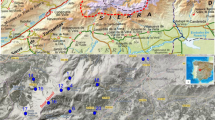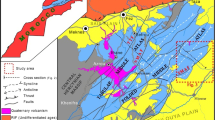Abstract
Although there are several available methods for the assessment and inventory of geomorphosites, when it comes to the comparative study of genetically similar landforms, one can note the need for further studies and analyses. The main reason for this fact is that most methods use criteria generally suitable for the evaluation of any landforms, thus not addressing the specificity of distinct geosites. Therefore, for the assessment of karst gorges in the Apuseni Mountains, a new specific method was used, a method adapted to the main features of the gorges in the study area. The method is based on the assessment of both the intrinsic values of geomorphosites (geomorphological, ecological, and aesthetic) and the functional ones (scientific, cultural, and tourism development). The criteria used to assess these values have been clearly explained, in order to ensure a more transparent assessment. Thus, a comparative study was possible and a hierarchy in terms of geotourism value of the 53 gorges in the Apuseni Mountains was developed, a hierarchy that can be a useful tool for geotourism promoters in the area.



Similar content being viewed by others
References
Brilha J (2015) Inventory and quantitative assessment of geosites and geodiversity sites: a review. Geoheritage. doi:10.1007/s12371-014-0139-3
Bruschi VM, Cendrero A (2005) Geosite evaluation: can we measure intangible values? Il Quaternario, Geomorphological Sites and Geodiversity 18(1):293–306
Bruschi VM, Coratza P, Piacentini D, Saliba D, Soldati M (2010) Valutazione dei geomorfositi del Majjistral Nature and Historic Park (Malta): due metodologie a confronto. Atti del Convegno Nazionale Il Patrimonio Geologico: una risorsa da proteggere e valorizzare, Sasso di Castalda-Potenza
Cocean G (2011) Munţii Trascău. Relief. Geomorfosituri. Turism. Presa Universitară Clujeană, Cluj-Napoca
Cocean G (2012) The inventory and hierarchy of geomorphosites in the Vlădeasa Massif. Revue Roumaine De Géographie 56(2):175–181
Cocean G (2014) Guidelines for including gorges into the touristic offer of the Apuseni MountainsRomanian Review of Regional Studies, Vol X, 2: 95–102
Cocean P (1984) Potenţialul economic al carstului din Munţii Apuseni. Editura Academiei Republicii Socialiste România, Bucureşti
Cocean P (1988) Chei şi defile din Munţii Apuseni. Bucureşti: Editura Academiei Republicii Socialiste România, Bucureşti
Cocean P (2000) Munţii Apuseni. Procese şi forme carstice. Editura Academiei, Bucureşti
Coratza P, Galve JP, Soldati M, Tonelli C (2012) Recognition and assessment of sinkholes as geosites: lessons from the Island of Gozo (Malta). Questiones Geographicae 31(1):25–35
Dowling RK (2011) Geotourism’s global growth. Geoheritage 3(1):1–13
Dowling RK, Newsome D (2010) Geotourism: a global activity. In: Newsome D (ed) Dowling, RK. Global Geotourism Perspectives, Oxford, Goodfellow Publishers, pp. 1–17
Farsani NT, Coelho CO, Costa CM (2013) Rural geotourism: a new tourism product. Acta Geoturistica 4(2):1–10
Feuillet T, Sourp E (2011) Geomorphological heritage of the Pyrenees National Park (France): assessment, clustering, and promotion of geomorphosites. Geoheritage 3:151–162
Goran C (1982) Catalogul sistematic al peşterilor din România. CNEFS, Bucureşti
Ianovici V et al. (1976) Geologia Munţilor Apuseni. Editura Academiei Republicii Socialiste România, Bucureşti
Joyce B (2007) Geotourism, geosites and Geoparks: working together in Australia. The Australian Geologist, Sydney, pp. 26–29
Lima FF, Brilha J, Salamuni E (2010) Inventorying geological heritage in large territories: a methodological proposal applied to Brazil. Geoheritage 2(3–4):91–99
Necheş IM (2013) From geomorphosite evaluation to geotourism interpretation. case study: the Sphinx of Romania’s Southern Carpathians. GeoJournal of Tourism and Geosites VI 2(12):145–162
Panizza M, Piacente S (2008) Geomorphology and cultural heritage in coastal environments. Geogr. Fis. Dinam. Quat. 31:205–210
Pereira P, Pereira D (2010) Methodological guidelines for geomorphosite assessment. Geomorphologie: relief, processus, environment 2:215–222
Pereira P, Pereira D, Alves MIC (2007) Geomorphosite assessment in Montesinho Natural Park (Portugal). Geographica Helvetica 62(3):159–168
Pralong JP (2005) A method for assessing tourist potential and use of geomorphological sites. Geomorphologie: relief, processus, environment 3:189–196
Reynard E (2008) Scientific research and tourist promotion of geomorphological heritage. Geogr Fis Dinam Quat 31:225–230
Reynard E, Fontana G, Kozlik L (2007) A method for assessing “scientific” and “additional values” of geomorphosites. Geographica Helvetica 62(3):148–158
Rodigues ML, Fonseca A (2010) Geoheritage assessment based on large-scale geomorphological mapping: contributes from a Portuguese limestone massif example. Geomorphologie: relief, processus, environment 2:189–198
Serrano E, Gonzalez Trueba JJ (2005) Assessment of geomorphosites in natural protected areas: the Picos de Europa National Park (Spain). Geomorphologie: relief, processus, environment 3:197–208
Serrano E, Gonzalez Trueba JJ (2011) Environmental education and landscape leisure. Geotourist map and geomorphosites in the Picos de Europa National Park. GeoJournal of Tourism and Geosites, IV 2(8):295–308
Wimbledon WAP (2010) Geosites—a mechanism for protection, integrating national and international valuation of heritage sites. Atti del Convegno Nazionale Il Patrimonio Geologico: una risorsa da proteggere e valorizzare. Sasso di Castalda–Potenza
Zouros N (2007) Geomorphosite assessment and management in protected areas of Greece. Case study of the Lesvos Island–Coastal Geomorphosites. Geographica Helvetica 62(3):169–180
Acknowledgments
This paper is a result of a postdoctoral research made possible by the financial support of the Sectoral Operational Programme for Human Resources Development 2007–2013, co-financed by the European Social Fund, under the project POSDRU/159/1.5/S/133391: “Doctoral and postdoctoral excellence programs for training highly qualified human resources for research in the fields of Life Sciences, Environment and Earth.”
Author information
Authors and Affiliations
Corresponding author
Rights and permissions
About this article
Cite this article
Cocean, G., Cocean, P. An Assessment of Gorges for Purposes of Identifying Geomorphosites of Geotourism Value in the Apuseni Mountains (Romania). Geoheritage 9, 71–81 (2017). https://doi.org/10.1007/s12371-016-0180-5
Received:
Accepted:
Published:
Issue Date:
DOI: https://doi.org/10.1007/s12371-016-0180-5




